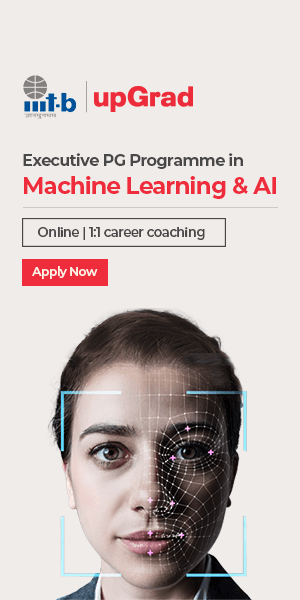Scientific and technological advancements are taking the world by storm. Just go back ten years and compare it to the life you lead today. You will realize the profound changes around us, thanks to new technological innovations making their way into our homes. We are also coming to know new terms like Artificial Intelligence (AI), Machine Learning (ML), Data Science, and many more.
Get Machine Learning Certification from the World’s top Universities. Earn Masters, Executive PGP, or Advanced Certificate Programs to fast-track your career.
Whenever we speak of Machine Learning or Artificial Intelligence, the first image that comes to our mind is that of machines and robots. But many of us don’t know that Machine Learning basics are commonly implemented in our daily lives.
Here you will get a detailed Machine Learning introduction along with some guidelines to learn Machine Learning python.
A brief Machine Learning introduction
Giving a precise and accurate Machine Learning introduction or definition is not simple. Experts in the field have given definitions that are too technical. For instance, Stanford’s definition of Machine Learning is, “Machine Learning is the science of getting computers to act without being explicitly programmed”. Beginners wanting to learn Machine Learning with Python must start their journey from such basic definitions.
In simple terms, Machine Learning is the capability of the machine to learn things on its own. The machine is fed with vast volumes of data, and the machine learns to interpret, process, and then analyze this data with the help of Machine Learning algorithms to solve real-world issues. The question that arises now is how a machine can learn on its own and solve challenging problems so easily? This takes us to the introduction to deep learning, where all our questions will be answered.
Some important Machine Learning terms and definitions that you must know
Knowing the basic terms and definitions of Machine Learning is an integral part of Machine Learning introduction. Here is a list of the standard terms used and their meanings:
- Model – The main component of Machine Learning is a model. A model gets trained by using a Machine Learning algorithm. It is the algorithm’s function to map all the decisions taken by the model based on the provided input so that the correct output is delivered.
- Algorithm – A Machine Learning algorithm is a set of statistical techniques and rules used to learn patterns from input data and then draw meaningful information from it. Algorithms are the central pillar behind the Machine Learning model.
- Predictor variable – This is a prominent data feature used to predict the output.
- Response variable – It is the output variable, which has to be predicted by using the predictable variable(s).
- Training data – Training data is used for building the Machine Learning model. With the help of training data, the model learns to identify key patterns and trends that are essential for predicting the output.
- Testing data – Once the model is trained, it has to be tested for evaluating how accurately it can give an outcome. Testing data set is done for confirmation.
The process of Machine Learning – introduction to deep learning
The process of Machine Learning includes building a Predictive model, which is used for finding a solution for a Problem Statement. These are the steps that are followed in a Machine Learning process:
Defining the objective of the Problem Statement
This is the first step, where we need to understand what needs to be predicted. At this stage, it is essential to take notes on what kind of data can be used to solve the problem or what approach should be followed to get a suitable solution.
Data gathering
This is the stage where you can ask various questions like, is any data available, is there any specific kind of data needed for solving this problem or how to get the data, etc. If you know the type of data you require, you have to find ways to get that data. Web scraping and manual collection are the two means of data collection. For beginners, just browse through the internet, get data resources, download them and use them.
Data Preparation
The collected data generally has many inconsistencies and might have the wrong format. It is crucial to eliminate all discrepancies. Otherwise, you might end up getting wrong predictions and computations. Scan the entire set of collected data and fix any kind of inconsistency.
Exploratory data analysis
This is probably the most exciting stage in the Machine Learning process. You have to explore the data rigorously and find any hidden data. Exploratory Data Analysis (EDA) is considered the brainstorming session of Machine Learning. You will be able to understand the trends and the patterns of data at this stage. Along with drawing valuable insights, correlations between variables are also well understood at this stage.
Building a Machine Learning model
Building a Machine Learning model is an integral part of the Machine Learning introduction. All the patterns and insights obtained in the data analysis stage are used for creating the model. In this stage, the data set is split into two sets – training data and testing data. Training data is used for building and analyzing the model. Machine Learning Algorithm is implemented at this stage. It is crucial to choose the correct algorithm depending on the kind of problem you are looking to sort.
Model Evaluation & Optimization
After the model is built using a training data set, the model will be tested. On receiving the testing data set, it is possible to check the model’s accuracy and outcome prediction. Depending on the accuracy quotient, model improvements are suggested and implemented. Model performance can be enhanced to a reasonable extent with tested procedures.
Predictions
After the model is thoroughly evaluated and enhanced, it is ready for making predictions, which is the final output.
What are the types of Machine Learning – Learn Machine Learning Python?
While talking about the basics of Machine Learning, there are three types:
- Supervised machine learning – In this kind of learning, you need to supervise and train the machine to work independently. A good example here is filtering spam mails from your email account.
- Unsupervised learning – It involves training data. But there will be no labeling or segregation. The system’s algorithm works on the data without any prior training. There are coded algorithms, and the output data will be according to that.
- Reinforcement learning – In this kind of learning, first, the system learns on its own. The reinforcement learning algorithm learns by the process of interaction with its environment.
Popular AI and ML Blogs & Free Courses
Conclusion
Now that you have a fair amount of Machine Learning introduction, you have an idea about Machine Learning to an extent. Data professionals, software and IT professionals, and engineers can learn Machine Learning python to enhance their career and professional abilities. So, next time you use Facebook’s auto-tagging feature, Amazon’s Alexa, do Google Search, carry out voice or face recognition, or use Google’s spam filters – know that Machine Learning works for all these.
Introduction to deep learning, Machine Learning with upGrad
If you are interested in mastering Machine Learning, you must enroll in upGrad’s Master of Science in Machine Learning and AI course. This is the most advanced certification program where candidates will learn to deploy Machine Learning models.




